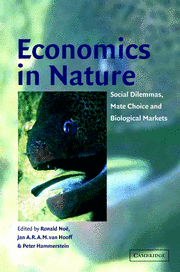Book contents
- Frontmatter
- Contents
- List of contributors
- Preface
- Acknowledgments
- 1 Games and markets: economic behaviour in humans and other animals
- Part I Economic behaviour in social networks
- Part II Biological markets
- 5 Biological markets: partner choice as the driving force behind the evolution of mutualisms
- 6 The utility of grooming in baboon troops
- 7 The cleaner fish market
- 8 Modelling interspecific mutualisms as biological markets
- Part III Mating markets
- Index
7 - The cleaner fish market
Published online by Cambridge University Press: 04 August 2010
- Frontmatter
- Contents
- List of contributors
- Preface
- Acknowledgments
- 1 Games and markets: economic behaviour in humans and other animals
- Part I Economic behaviour in social networks
- Part II Biological markets
- 5 Biological markets: partner choice as the driving force behind the evolution of mutualisms
- 6 The utility of grooming in baboon troops
- 7 The cleaner fish market
- 8 Modelling interspecific mutualisms as biological markets
- Part III Mating markets
- Index
Summary
Introduction
The interaction between ‘cleaners’ and their ‘clients’ is one of the most amazing interspecific interactions one can witness on coral reefs. Cleaners are small fish and shrimps that inspect the body surface and the inside of the gill chambers and mouth of larger fish, the clients, in search for ectoparasites and dead or infected tissue (Eibl-Eibesfeldt 1955; Randall 1955; Limbaugh et al. 1961, reviews: Feder 1966; Losey 1987; Losey et al. 1999). Cleaning seems to be ubiquitous in aquatic systems, and many fish species are known to be facultative cleaners as juveniles (review by Wirtz 1998). The highest degree of specialisation is found in coral reefs, where a few members of the Labridae and Gobiidae families evolved into highly specialised cleaners which feed almost exclusively on material they remove from clients (Losey et al. 1999). Most work has been done on the two cleaner wrasses Labroides dimidiatus and L. phthyrophagus (Losey et al. 1999). These cleaners live in small territories, the so-called cleaning stations. Clients actively visit these cleaning stations and often use special postures to signal their wish to be inspected (Randall 1958; Losey 1971). Clients visit cleaners several times a day, some up to an estimated 144 times a day for a total of 30 min. (Grutter 1995).
Since the 1950s, scientists tried to solve the puzzle of this apparent mutualism. After early descriptive work, the question of the impact of cleaning on client fitness was tackled. Experiments in which cleaners were removed from relatively small coral reef heads (‘patch reefs’) which are isolated by sand from other reef areas, yielded inconclusive results concerning changes in fish densities and parasite loads (Limbaugh 1961; Youngbluth 1968; Losey 1972; Gorlick et al. 1987; Grutter 1997a).
- Type
- Chapter
- Information
- Economics in NatureSocial Dilemmas, Mate Choice and Biological Markets, pp. 146 - 172Publisher: Cambridge University PressPrint publication year: 2001
- 65
- Cited by

